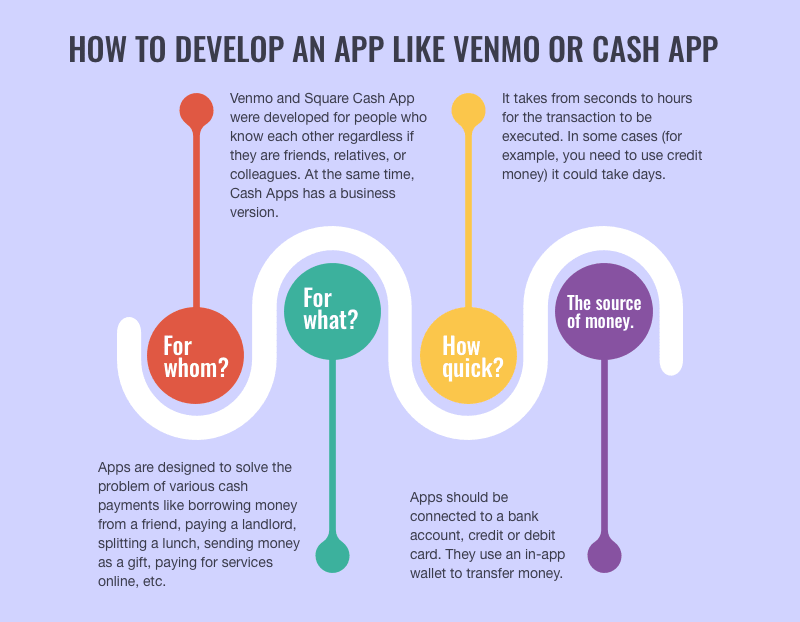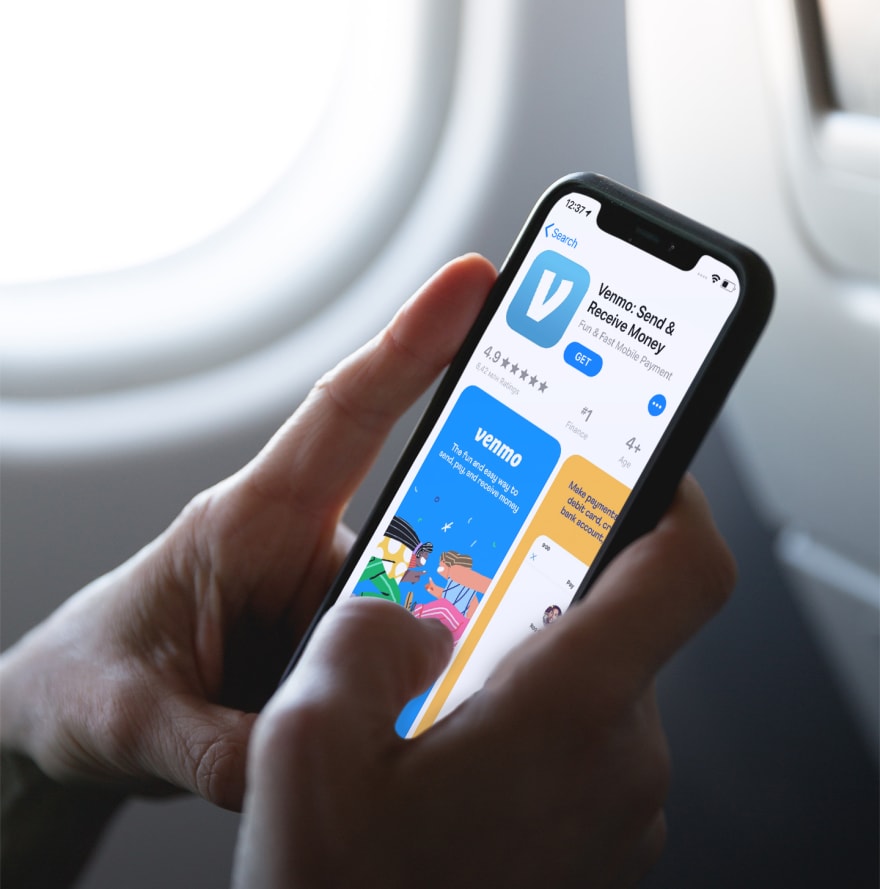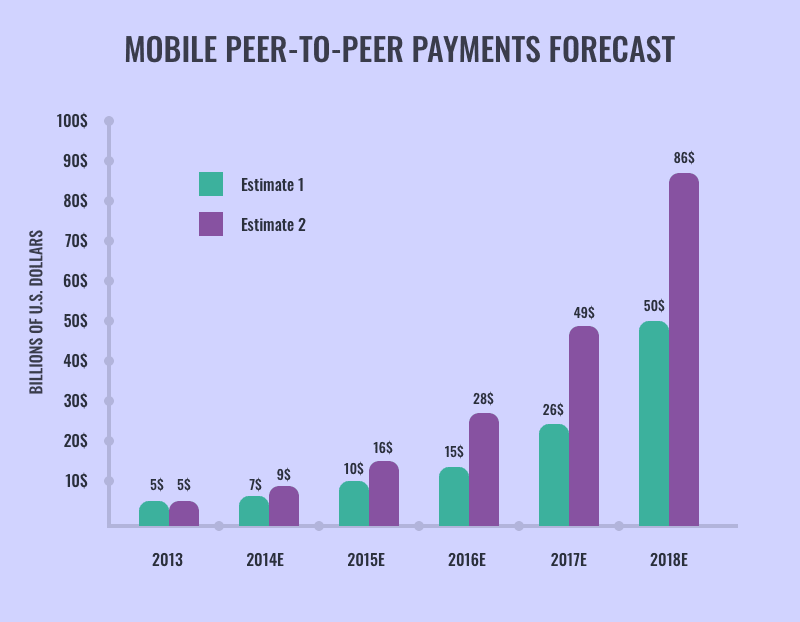Before asking yourself “How to make an app like Venmo?” make sure you fully understand the peer-to-peer mobile payment specifics.
P2P money transfers have lots of features that were not common for a global banking world. Square Cash, Venmo, Dwolla, Google Wallet, or any Venmo clones are usually card-free and cashless, they use contactless payment technologies and execute money transfers in one click.
The key idea of P2P payment services is to provide users with a tool to send and receive money without ATM cash withdrawal or payment terminals designed by banks.
Although there are several types of mobile peer-to-peer payment apps, we’d like to focus on the question of how to create an app like Venmo and Cash. Both of them are free for users, they are also self-standing digital products for their developers and considered to be global leaders of their niche.
How to Develop an App Like Venmo or Cash App? Peer-to-Peer world rules
The first thing you need to get accustomed to creating an app like Venmo is that mobile peer-to-peer (or person-to-person) payment services have very few features in common with basic PayPal or Western Union if you look at them from a user experience point of view. However, both of them offer person-to-person money transactions. Here are some critical features of Venmo and Cash App:
- For whom? Venmo and Square Cash App were developed for people who know each other regardless if they are friends, relatives, or colleagues. At the same time, Cash Apps has a business version.
- For what? Apps are designed to solve the problem of various cash payments like borrowing money from a friend, paying a landlord, splitting a lunch, sending money as a gift, paying for services online, etc.
- How quick? It takes from seconds to hours for the transaction to be executed. In some cases (for example, you need to use credit money) it could take days.
- The source of money. Apps should be connected to a bank account, credit or debit card. They use an in-app wallet to transfer money.
P2P payment services differ by business model, location, character, and even field of usage. In this case, Venmo and Cash App are cross-border standalone financial services, created for all types of peer-to-peer money transfers and payments. Other examples — Alipay and Airfox.
How much does Venmo cost? To answer the question we need to look deeper into Venmo nature. Venmo and Square Cash are services for online P2P and C2B (client to business) payments. They have an online wallet feature that allows users to store some money inside the services and use them for quick payments. If there is no money on the Venmo or Cash App accounts, apps will charge from your bank account or credit (debit) card.
Don’t confuse Venmo with bank-centric apps (Dwolla and PopMoney) and social platforms’ inbuilt online paying tools of Facebook Messenger, Snapchat, and WeChat.
Mobile OS native payment services are another type of Venmo and Cash App competitors. They are device-based and more secure, often linked directly to your bank account. Examples — Apple Pay and Google Pay
How Much Did It Cost to Make Venmo? Step by step development explainer
In our article titled “I Have an App idea Now What” we gave details on each mobile app development step and in our article named “How Much Does It Cost to Build an App” you may find general calculations separated by the project stage and teammates involved into the process. Check them to get more information on the topic.
And here, we’d like to look through those peer-to-peer app development stages that are significant for your commercial success.
- Discovery stage. Consider what modes of payments and features you really need All P2P mobile apps have similar functions — they help people to pay others cashless and quickly receive payments from mates. To meet users’ needs, you have to create a P2P network, develop a way to support various online e-commerce payments, and link your service to bank systems.
To understand what payment modes you need, evaluate what kind of money communication you expect. Maybe, you’d like to focus on on-the-spot payments? Or you plan to work with a special audience that would use an installment plan to pay their landlords? Or, perhaps, your app will be dedicated to those who’d like to respond friend-to-friend borrowing requests wisely?
- Development & Testing stage. Consider a security level of your app and financial data synchronizing potential What does Venmo cost? Developing apps like Venmo means taking a huge responsibility. Fingerprint verification and identification, several security check levels, personal and financial data encryption — all those features will cost you money, but it’s impossible to launch a payment app without being sure that it is secure.
Another question sounds like — are you sure that your app will accurately transfer money? Losing money while trying to transfer them from one bank account to another is another serious risk that you need to consider. Deal with the fact that you will need to invest a lot of money in product testing to avoid such drawbacks.
Development stage. Proper data architecture and app capabilities
Most likely, you assume that the audience of your product will grow rapidly. Keep in mind that financial transactions (as well as their verification) require the huge power of your servers. Get technically ready to serve a large number of people to avoid system overloading and loss of client data. The correct data structure will also help to cope with the task. At this point, you will need to collaborate with experienced digital engineers.Discovery & Development stage. Tech solution and integrations
How to make a Venmo? As we wrote above, you should know which customers you serve and what problem you are solving for them. For example, Venmo is designed for individual users' payments as well as regular transactions to private entrepreneurs’ accounts (homeowner, taxi driver, a seller in the market, and others).
Your tool will probably work more efficiently if you integrate e-commerce platforms, calendars, platforms for calculating the family budget and social networks into it. Analyze your audience to find out what services they use and what might be useful to them.
Also, consider the devices these people use.
Core Venmo or Cash App Features
How much is the Venmo app or Square Cash? The basic factor that affects an app development budget is the number and complexity of features you’d like to have in your product.
Consider that Venmo and Cash have a different set of functions and are designed to serve different types of customers. Below, we gave you the list of their core features. The same ones should be implemented in your MVP. Read more about MVP development and the Lean approach in our blog.
Venmo app
In 2019, Venmo is the most successful app in the category created by the University of Pennsylvania roommates Iqram Magdon-Ismail and Andrew Kortina. It helps people to proceed with fast money transfers between each other without using ATM or writing checks. The Venmo MVP looked like a tool to send money using text messages.
Venmo startup was raised by Braintree fintech payments company which is a part of PayPal since 2013. In 2015, PayPal started Venmo promotional campaign and added several features to its operating algorithms that soon made the app significantly popular among youngsters. In 2019, Venmo gained 40 million unique users.
Today’s Venmo functions are the following:
- Peer-to-peer payments and money tracking
- Bank accounts and cards linking
- Point of sale (POS) purchases
- Payment sharing and bills splitting
- Facebook and phone contacts integration
- Sending tickets via email or messengers
- Money requests sending
- Comments and emojis
- Authorization, profile editing, and account setting
- Inbuilt mobile wallet
- Regular or planned payments
- Cash-out to a bank account
Venmo has also data storage and uses a reliable data encryption mechanism. But why is it so popular? The answer is — Venmo is simple and fast. Its users need to follow just 4 steps to execute their first transaction: download the app, sign-up and link bank account (or card), find a person to send or request money, and approve the action! Venmo will check inbuilt Venmo wallet balance and then proceed with your request.
Cash App by Square
How much does Venmo make comparing to another P2P payment service called Cash? The last one was developed by Square and dedicated to both private users and businesses. You could have one or two accounts on Square Cash depending on your aims to use it.
A personal account is suitable for those who plan to send money to friends. The business account was designed for enterprises that plan to receive money for the products they sell online.
Square Cash is a former name of Cash App which was developed in 2015. Its MVP idea was to provide individuals, organizations, and businesses with a tool to send and receive payments using a short tag called $cashtag. The number of Cash App active users reached 7 million in 2018.
Today’s Cash App functions are the following:
- Personal and business account types
- Cash App money account with physical free Cash Visa Debit card
- Phone number and email verification
- Bank account linking
- Fingerprints scanning to unlock the account
- Peer search by entering Cash App code or email
- Money requests sending
- Online stores payment with virtual Cash App card
- Protection program for businesses (chargebacks)
- Bitcoins trading
Square Cash is not just a single app. You could reach its functions using Cash App on your mobile devices, Cash.me website, iMessage (for Apple users only), and even Siri. Those integrations made Square Cash more flexible and multifunctional comparing to Venmo. However, Cash could only be used on the US territory.
How Venmo and Square Cash App Make Money
How does Square Cash make money? Both Venmo and Cash app are free to download and use. They also have no ads inside. However, PayPal, the Venmo’s current owner, reported $15.5 billion 2018 revenue gained by the app and Square reported that Cash App generated over $166 million in bitcoin and got a profit of $1.7 million for the same period. So what’s their secret? Let’s analyze their revenue sources!
Venmo monetization algorithm
How does Venmo make money? Venmo-powered transactions cost you nothing if you are a private user, but businesses that receive payments through the Venmo system have to pay a 2.9% fee. 2 services generate Venmo incomes — Venmo API and Venmo Touch. The first one allows third-party websites to get and send Venmo invoices. Venmo Touch is a tool for quick purchases used by sellers to speed up deals.
The only case in which Venmo will charge you money is a credit card transaction. Individuals are charging 3% by the app if they are spending money they don’t have.
Cash App monetization algorithm
Creating Cash App means working out a more complicated monetization strategy comparing to Venmo. First of all, it serves a wider range of clients. The main revenue source is a transaction fee. The commission is paid by a seller and is 2.75% for card-based actions and 3.5% + $0.15 for each no-card transaction.
One more difference of Cash App from the Venmo app creator is the following — Square produces software and hardware solutions considering its field. Examples — a collaboration with Starbucks and Caviar delivery service.
Cash App is also integrated into a larger fintech ecosystem which includes Square Capital, Square Appointments, and Square Customer Engagement. Square hardware revenue comes from Square Stand and Square Readers for EMV chip cards, cash drawers, receipt printers, and barcode scanners. Those items could be integrated with Square Stand that works as a POS system.
How Much Does Square Cash Cost? Cash App and Venmo Development Estimation
According to the Lean Startup concept, there is no need to develop a full scope app to find out if it is demanded or not and check how much money it could bring you. Start with MVP, an app or other product that performs core ideas and functions only and wait for user feedback.
In our blog article dedicated to MVP development find more information on the approach and here, get to know how to make an app like Square Cash App and Venmo as an MVP. Here are minimum viable product features:
- Fingerprints scan and security code verification 60 hours
Your app needs to have a high-security level as you are dealing with people’s bank accounts and funds. Develop a good-working and fast-operating authorization algorithm. Fingerprints scanning is now the most appropriate technology to make the process secure and fast.
- Money sending and requesting tool 80 hours
It’s impossible to make Cash App without this basic feature. You may skip bill splitting or credits for the first time, but you can’t avoid developing a money transfer feature. Consider that an app needs to be incorporated into a global (or local) banking environment. In other words, you need a bank account linking inside the app.
- Virtual card, account, and wallet 160 hours
To proceed with P2P payment one needs to find a peer inside the app. Cash App and Venmo have inbuilt personal electronic wallets that are money buffers for all transactions. The wallet can be used as a money source while purchasing goods, or you can use money received on it to send to someone else.
- Account setting and activity monitoring 24 hours
Cash App and Venmo have something in common with social networks. They also have personal profiles and link people. Any app like this needs to have a tool to set up notifications, change profile information, manage contacts, and monitor past transactions.
Looks too simple? Remember, that fintech apps are rather about UX, data architecture, and security level than features. In other words, you are likely to spend a lot of money on designers, data engineers, and QA, and less money on developers. Some factors will influence final estimations:
- Supported devices and mobile platforms
- Integrations (bank databases and commercial apps)
- UX and UI complexity
- Hardware features incorporation
- Ongoing tech support level
In this paragraph, we’ve decided to estimate the lowest level app of Venmo or Cash App kind. For that kind of app development, you’ll probably need such teammates: developer and data engineer (could be one person), PM, designer, QA, and marketer.
Your potential designer is likely to spend 100 hours on a basic Venmo-like app with features listed above. QA will spend 120 hours as a minimum to evaluate the quality of your product. Project management will cost you around 15% of all development budget.
The entire app building process will normally consist of 4 stages — Discovery (Research), Design, Development, and Deployment. The last one also consists of testing substage.
We assume that a Square Cash clone MVP will cost you 25 000$ and the development can last from 3 to 5 month. Remember, that LANARS has Eastern European hourly rates (from 40—60$ per hour).
How to Make an App Like Venmo? Conclusion
The mobile payments market is still growing and it is believed that soon most of the transactions will be cashless. Significant fact: Allied Market Research says that global mobile payment transactions will generate over $4.3 trillion by 2023.
Mobile wallets like Venmo, virtual or physical card-based payments, carrier billing, as well as contactless NFC payments and direct P2P transfers are major technologies adopted by modern customers and businessmen these years. Although WeChat Pay is the biggest mobile payment platform of 2019 (it has 1 billion users) there is still enough space for fintech mobile payment startups similar to Venmo and Cash App for local markets.
That was also forecasted that the global user adoption of mobile payment apps will increase to 28% till the end of 2020 globally (comparing to 16% of 2019) which means that there will be even bigger demand on P2P payment solutions next year.
The cashless transaction app niche also becomes more attractive if you look at it from innovative solutions prospective. Perhaps it's time to invest resources in new solutions, not clones?












Top comments (2)
Interesting guide, thanks! For a more detailed understanding of the cost factors associated with mobile banking app development, I advice to check out the article here: cleveroad.com/blog/banking-app-dev...
Hi,
your article is very interesting.
What third-party services could be used to create your app?